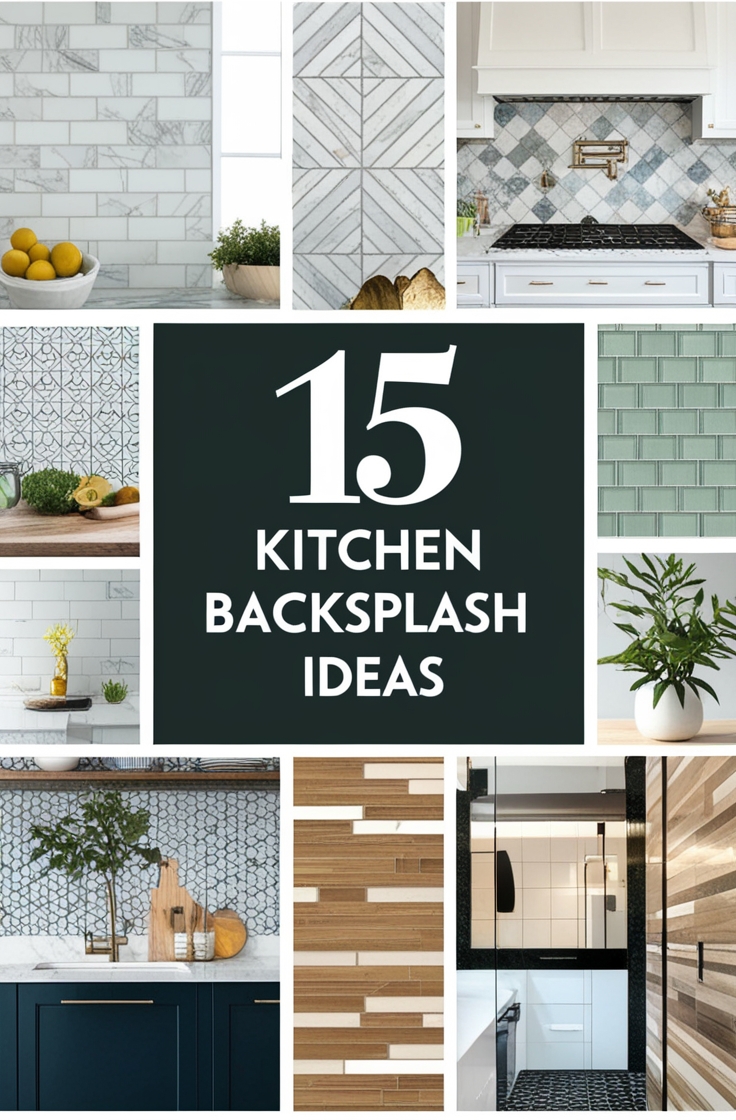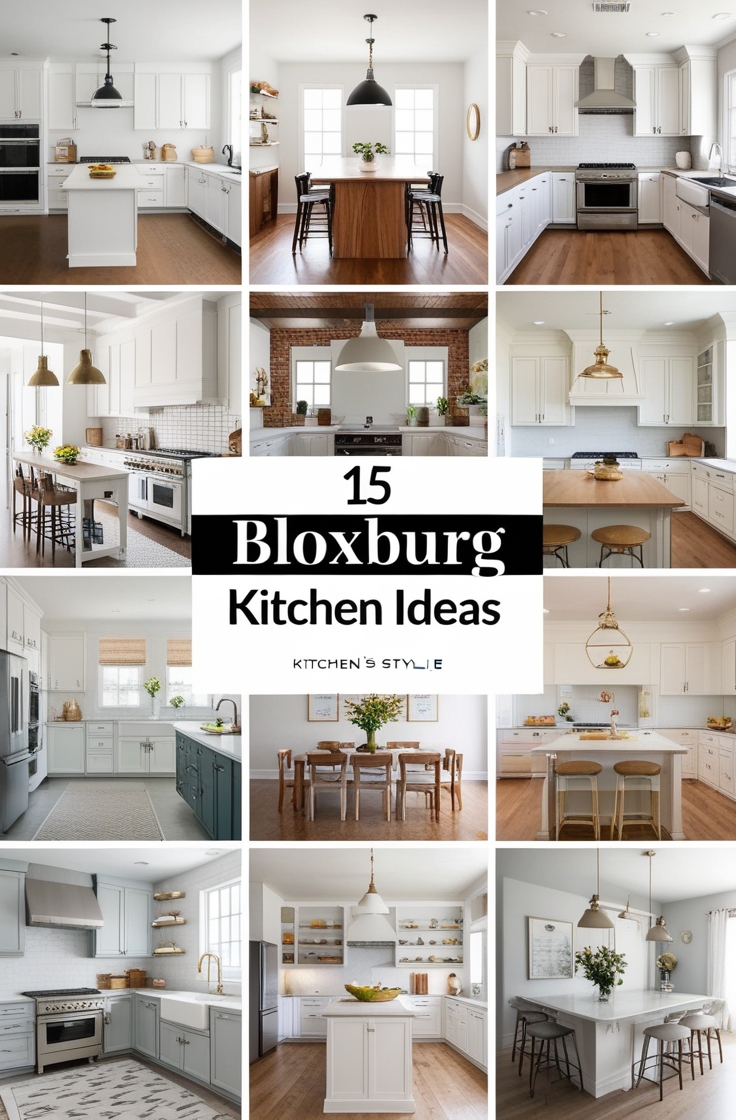Flooring might not be the first thing you think about when it comes to your kitchen, but it makes a huge difference. It’s the surface you stand on while cooking, the spot where crumbs fall, and sometimes where conversations happen over a late-night snack.
The right flooring pulls the whole room together—and it needs to handle daily life while still looking good. Whether you’re planning a full remodel or just browsing for ideas, I’ve rounded up 15 kitchen flooring options that work for all kinds of styles, budgets, and spaces.
From classic to modern, bold to practical, there’s something here worth considering. Let’s take a look at what might work best in your kitchen.
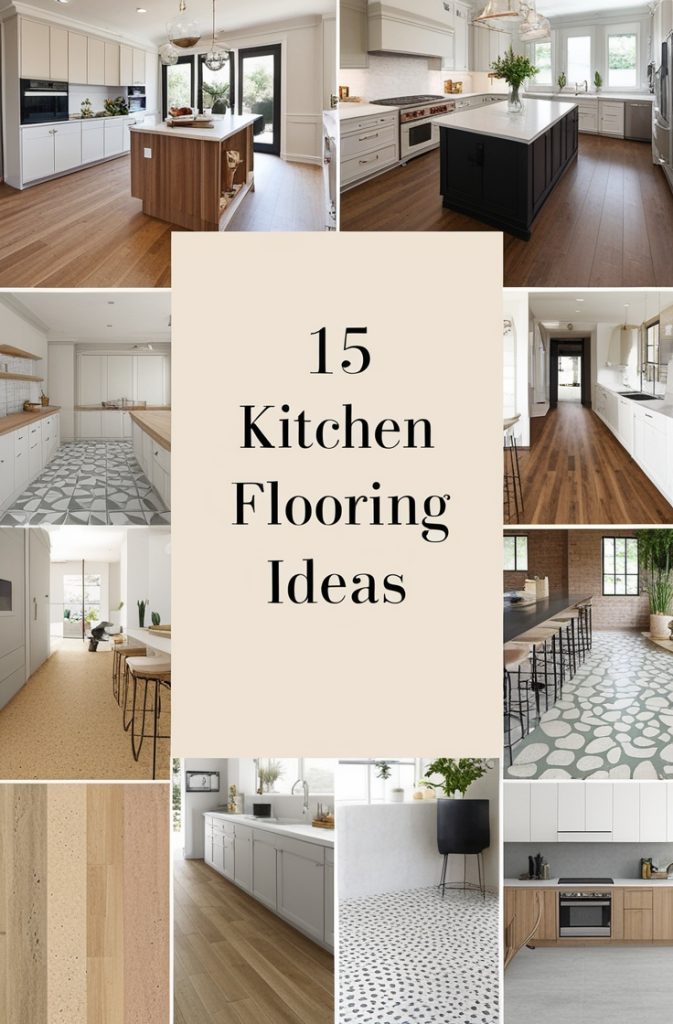
Table of Contents
- Key Considerations for Choosing Kitchen Flooring
- 15 Kitchen Flooring Ideas
- 1. Hardwood Flooring
- 2. Engineered Hardwood
- 3. Porcelain Tile
- 4. Ceramic Tile
- 5. Luxury Vinyl Plank (LVP)
- 6. Vinyl Sheet Flooring
- 7. Cork Flooring
- 8. Bamboo Flooring
- 9. Concrete Flooring
- 10. Natural Stone Tile (e.g., Slate, Marble, Travertine)
- 11. Terrazzo Flooring
- 12. Brick Flooring
- 13. Patterned Cement Tiles
- 14. Laminate Flooring
- 15. Linoleum Flooring
- Comparison of Flooring Options
- Design Tips for Kitchen Flooring
- Installation and Maintenance Tips
- Budget Planning and Cost Breakdown
- Eco-Friendly and Sustainable Options
- Conclusion
Key Considerations for Choosing Kitchen Flooring
Before we explore the flooring options, let’s think about what matters most for your kitchen. Kitchens are busy places. They need flooring that can handle spills, foot traffic, and the occasional dropped spatula. Here are the key factors to keep in mind.
Durability
Your kitchen floor takes a beating. Think heavy foot traffic, dropped dishes, and splashes of sauce. You’ll want a material that stands up to daily wear and tear. Some options, like porcelain tile, are nearly indestructible, while others, like hardwood, need a little extra care.
Maintenance
Nobody wants to spend hours scrubbing floors. Choose a material that’s easy to clean. Vinyl and tile are wipe-and-go, while natural stone might need periodic sealing. Consider how much time you’re willing to dedicate to upkeep.
Aesthetics
Your floor sets the tone for your kitchen’s style. Love a cozy, rustic look? Hardwood or brick might be your vibe. Craving something sleek and modern? Polished concrete or large-format tiles could be perfect. Think about how your flooring will complement your cabinets, countertops, and overall design.
Budget
Flooring costs can range from a few bucks per square foot to a small fortune. There’s something for every wallet, whether you’re splurging on marble or sticking to budget-friendly vinyl. Don’t forget to factor in installation costs, too.
Comfort and Safety
Kitchens mean standing for long periods—think chopping veggies or baking cookies. Softer materials like cork or vinyl feel better underfoot. If you’ve got kids or pets, slip-resistant options are a must for safety.
Installation
Some flooring, like luxury vinyl planks, is DIY-friendly. Others, like terrazzo or natural stone, often require a pro. Consider your skills and budget when choosing. Professional installation can add to the cost but ensures a flawless finish.
Sustainability
If you’re eco-conscious, you’ll love options like cork or bamboo. These materials are renewable and kind to the planet. Look for certifications like FSC for wood or low-VOC for healthier air quality.
Now that we’ve got the basics down, let’s dive into the fun part: the flooring ideas!
15 Kitchen Flooring Ideas
Here are 15 kitchen flooring options, each with its own personality and perks. I’ll break down what makes each one special, so you can find the perfect fit for your kitchen.
1. Hardwood Flooring
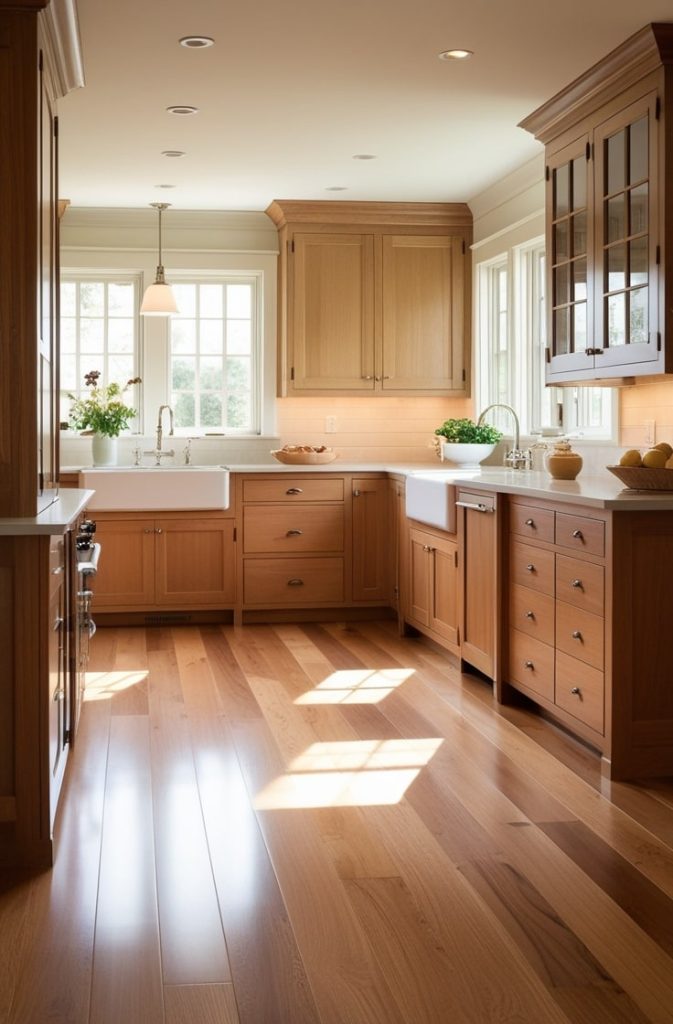
I love the warmth of hardwood floors. They bring a timeless, classic vibe to any kitchen. Hardwood is durable, especially with a good sealant, and it adds real value to your home. You can choose oak, maple, or walnut for different looks.
The downside? It’s sensitive to water, so spills need quick cleanup. Maintenance involves periodic refinishing, which can be a hassle. Hardwood shines in traditional, farmhouse, or luxury kitchens. Expect to pay mid to high-end prices, but the elegance is worth it.
2. Engineered Hardwood
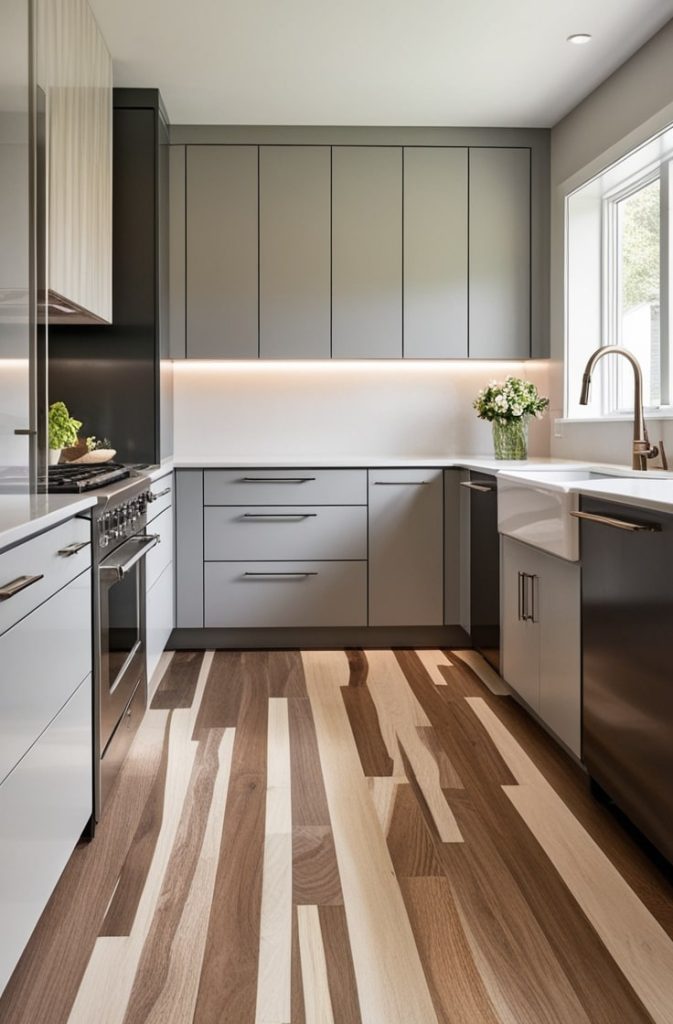
If you love hardwood but worry about moisture, engineered hardwood is a great compromise.
It’s made of a real wood veneer over layered plywood, making it more stable in humid kitchens. It’s slightly cheaper than solid hardwood and easier to install.
The catch? You can only refinish it a few times due to the thin top layer. It’s perfect for modern or transitional kitchens and falls in the mid-price range.
3. Porcelain Tile
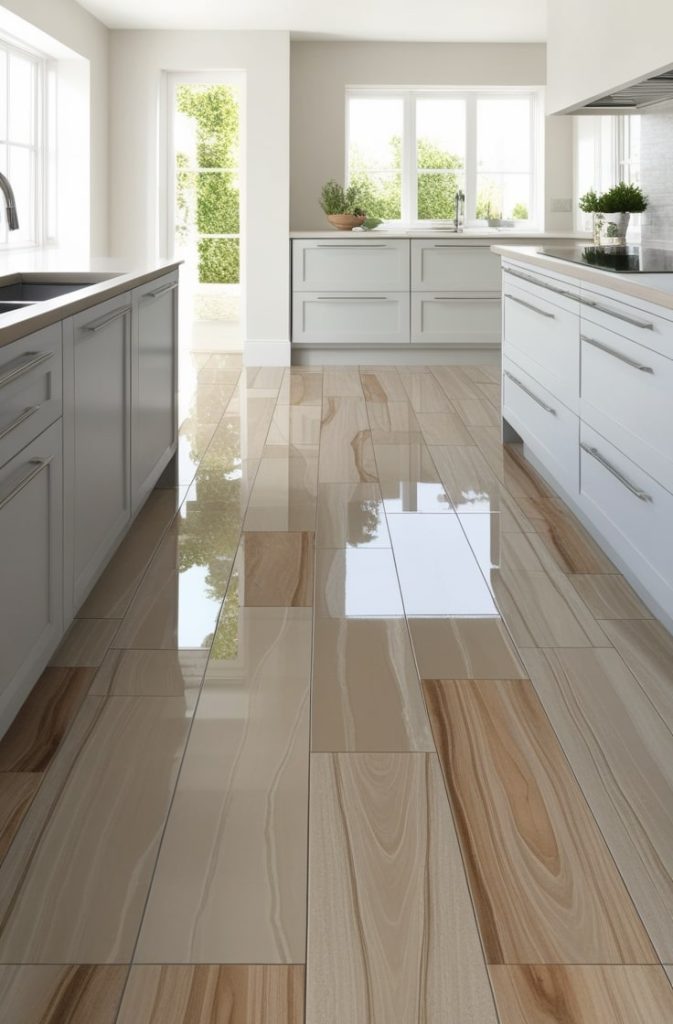
Porcelain tiles are my go-to for durability. They’re tough, water-resistant, and come in endless designs—think wood-look planks or sleek stone finishes.
They’re low-maintenance; a quick sweep and mop keep them sparkling. The downside? They can feel cold and hard underfoot, so consider adding a rug for comfort.
Installation can be tricky, often requiring a pro. Porcelain is ideal for contemporary or eclectic kitchens and ranges from mid to high-end in cost.
4. Ceramic Tile
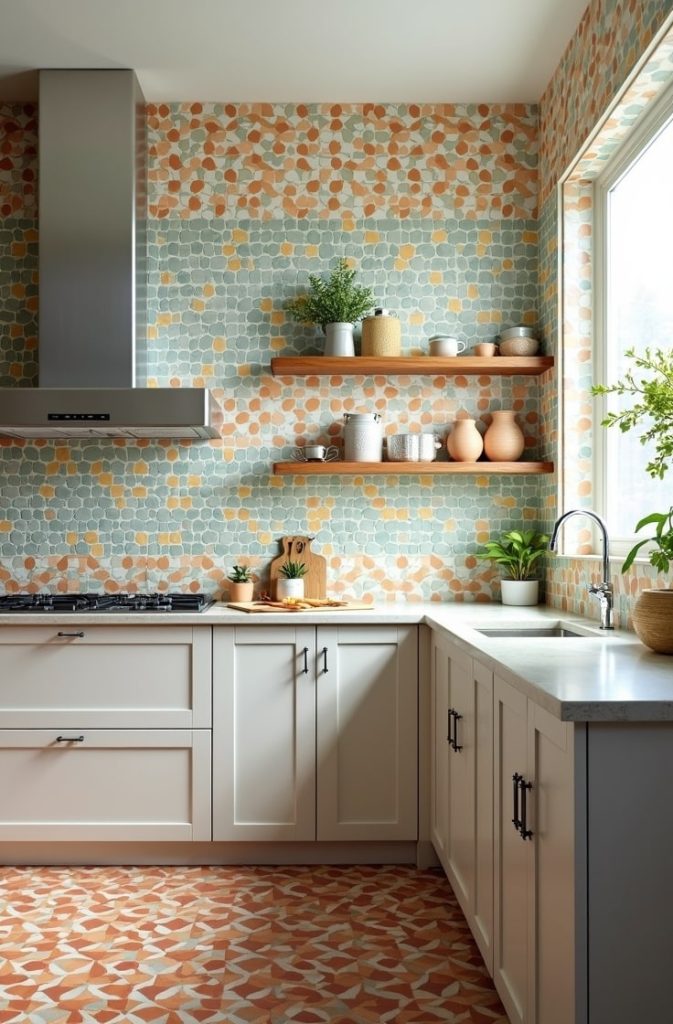
Ceramic tiles are like porcelain’s budget-friendly cousin. They’re versatile, easy to clean, and available in countless colors and patterns. You can create a bold mosaic or a simple subway tile look.
They’re less durable than porcelain and can crack under heavy impact, but they’re perfect for renters or anyone watching their wallet. Ceramic fits budget-conscious or rental kitchens and costs less than porcelain, staying in the low to mid-range.
5. Luxury Vinyl Plank (LVP)
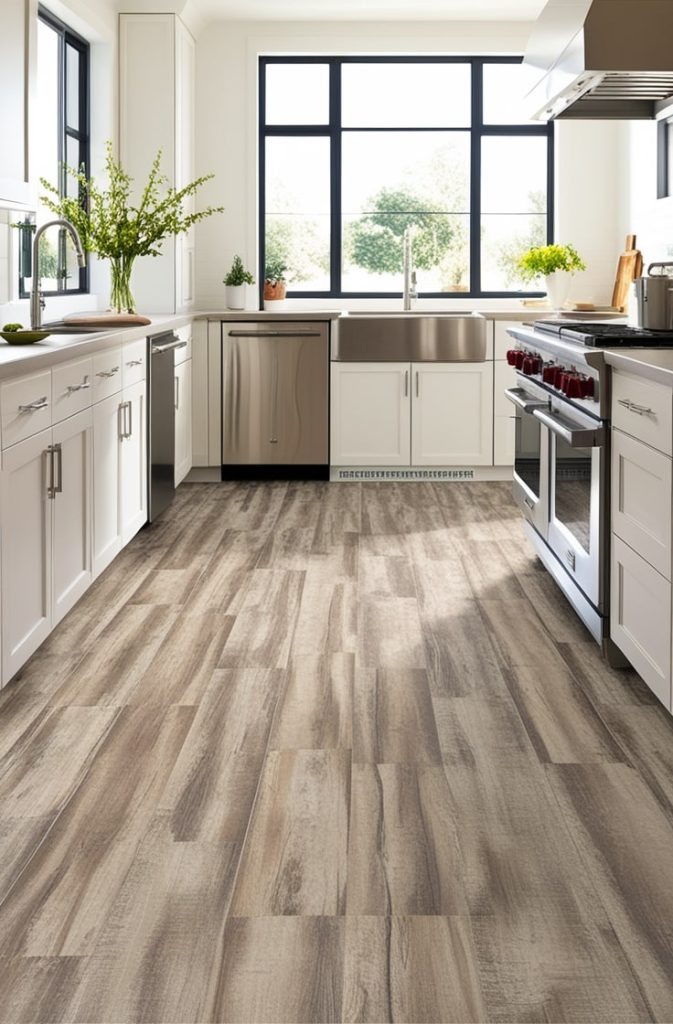
Luxury vinyl planks are a game-changer. They mimic wood or stone but are way more affordable and water-resistant. I’ve seen LVP transform kitchens on a budget, and it’s super easy to install—many are click-and-lock for DIYers.
They’re not as durable long-term as hardwood or tile and might not boost your home’s value. Still, they’re perfect for high-traffic or budget-friendly kitchens. Prices are low to mid-range, making LVP a crowd-pleaser.
6. Vinyl Sheet Flooring
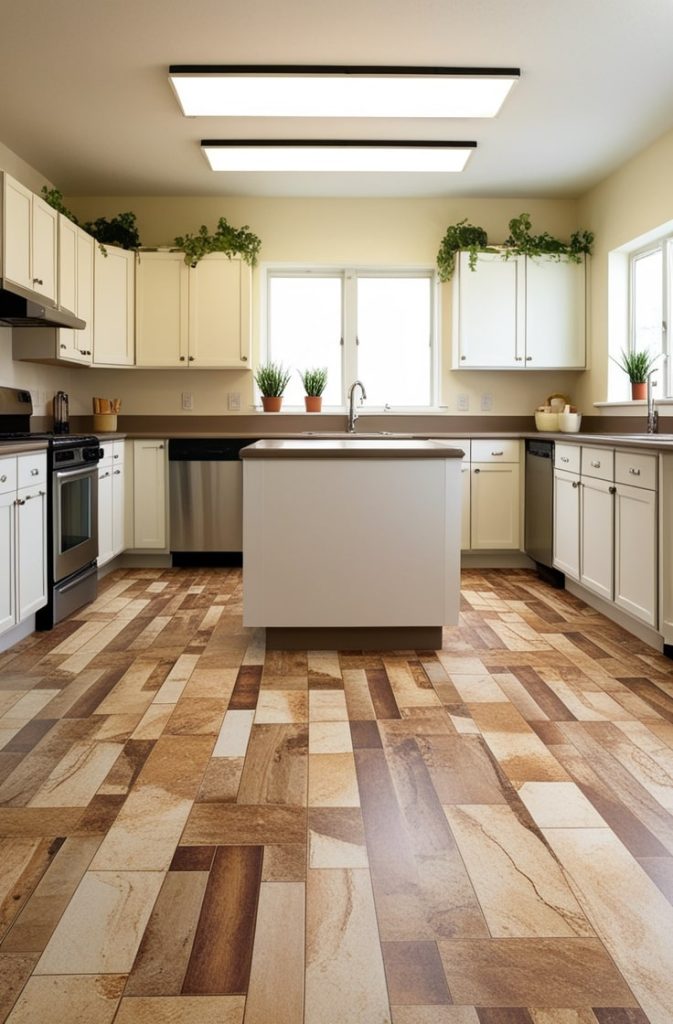
Vinyl sheet flooring is the ultimate budget option. It comes in large rolls, creating a seamless look that’s water-resistant and easy to clean. You can find patterns mimicking stone, wood, or even tile.
It’s not the most luxurious, and it can tear if you’re not careful, but it’s a fantastic choice for rentals or temporary fixes. Vinyl sheets are dirt cheap, making them ideal for low-budget projects.
7. Cork Flooring
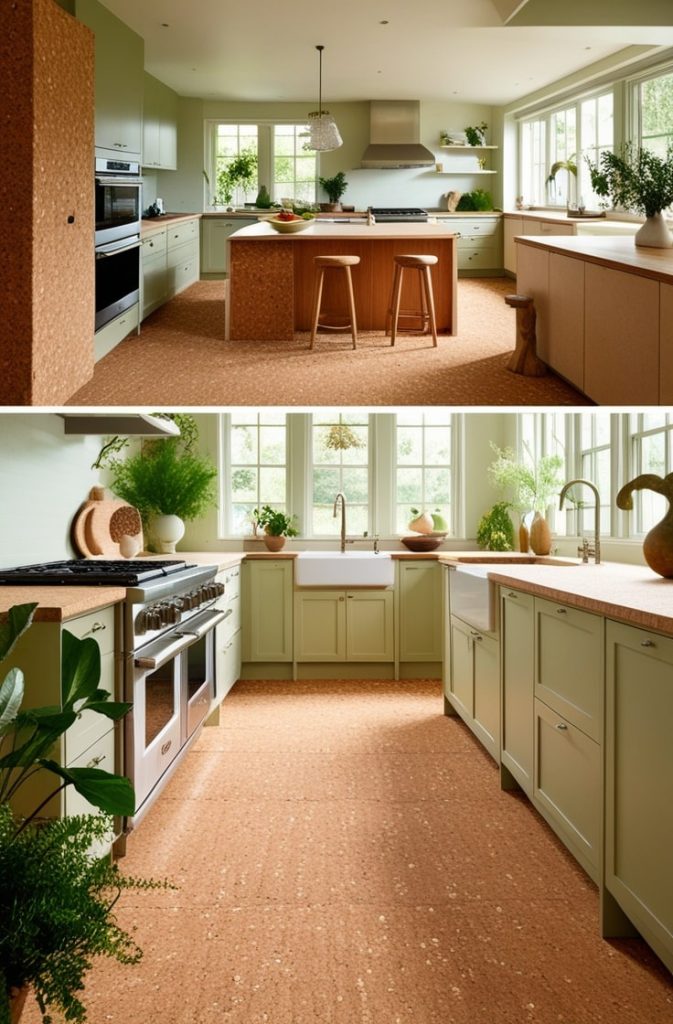
Cork is one of those under-the-radar options I adore. It’s soft, cushioned, and eco-friendly, made from the bark of cork oak trees. It’s a dream to stand on while cooking, and it absorbs sound, perfect for open-plan homes. Scratches and dents are a risk, so it needs regular sealing. Cork suits eco-conscious or cozy kitchens and falls in the mid-price range. Plus, it’s a conversation starter!
8. Bamboo Flooring
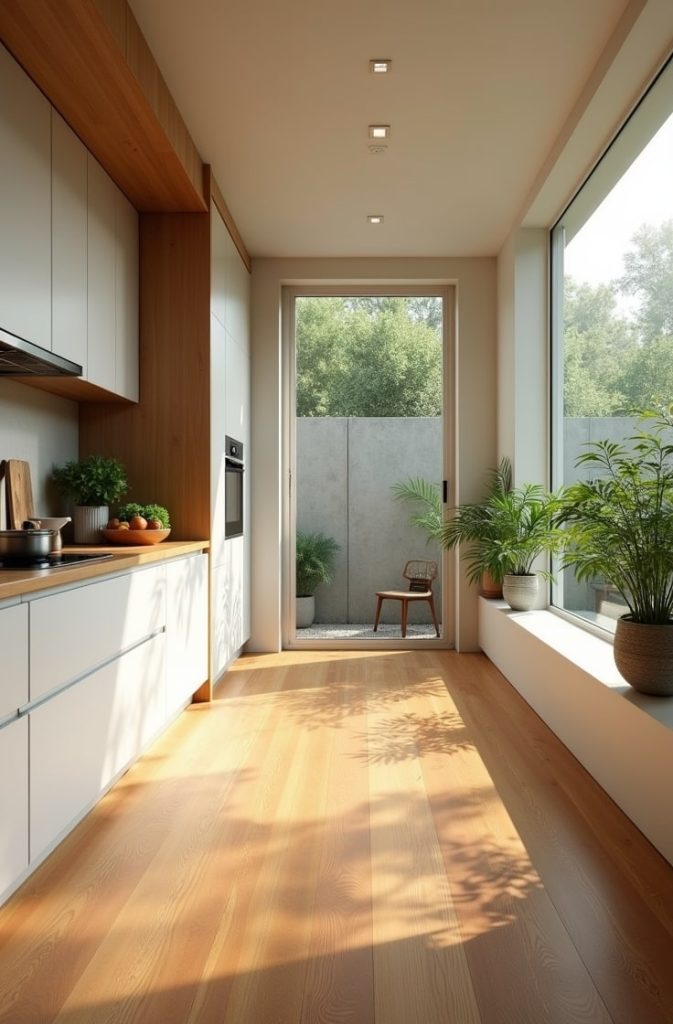
Bamboo is like hardwood’s sustainable sibling. It’s fast-growing, eco-friendly, and has a unique grain that adds character. It’s durable but needs protection from moisture, much like hardwood.
The color palette is limited, but the natural look is stunning. Bamboo works beautifully in modern or eco-friendly kitchens and costs mid to high-end. It’s a great way to make a green statement.
9. Concrete Flooring
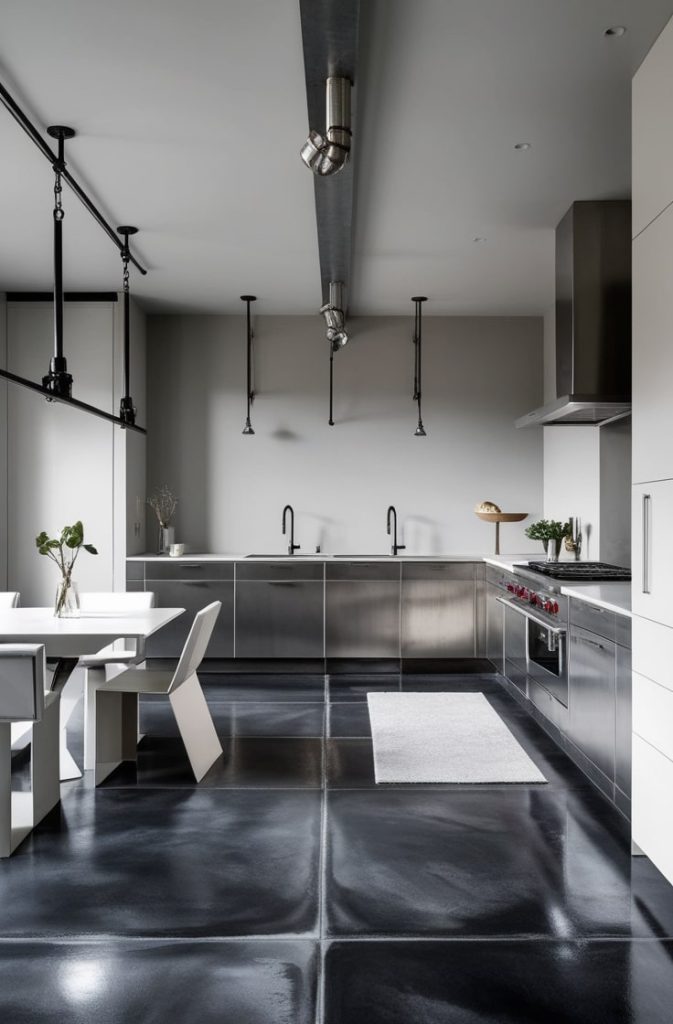
Concrete floors are bold and industrial. You can polish them for a sleek look or stain them for color and depth. They’re incredibly durable and low-maintenance, perfect for busy households. The downside? They’re cold and hard, so you might want a rug for comfort. Cracks can form over time, especially in older homes. Concrete is ideal for minimalist or industrial kitchens and costs mid to high-end, depending on customization.
10. Natural Stone Tile (e.g., Slate, Marble, Travertine)
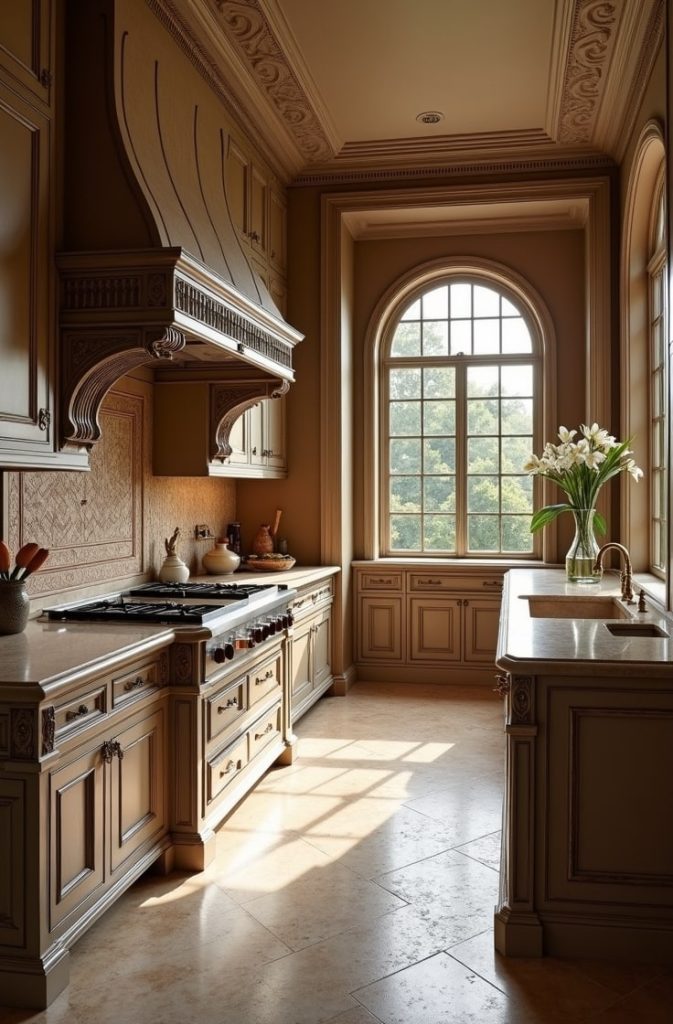
Natural stone tiles scream luxury. Slate, marble, or travertine each bring unique textures and colors. They’re durable and add serious wow-factor, but they’re pricey and need regular sealing to prevent stains.
They can also be slippery, so choose textured options for safety. Stone tiles are perfect for high-end or Mediterranean-style kitchens. Expect high-end costs, but the elegance is unmatched.
11. Terrazzo Flooring
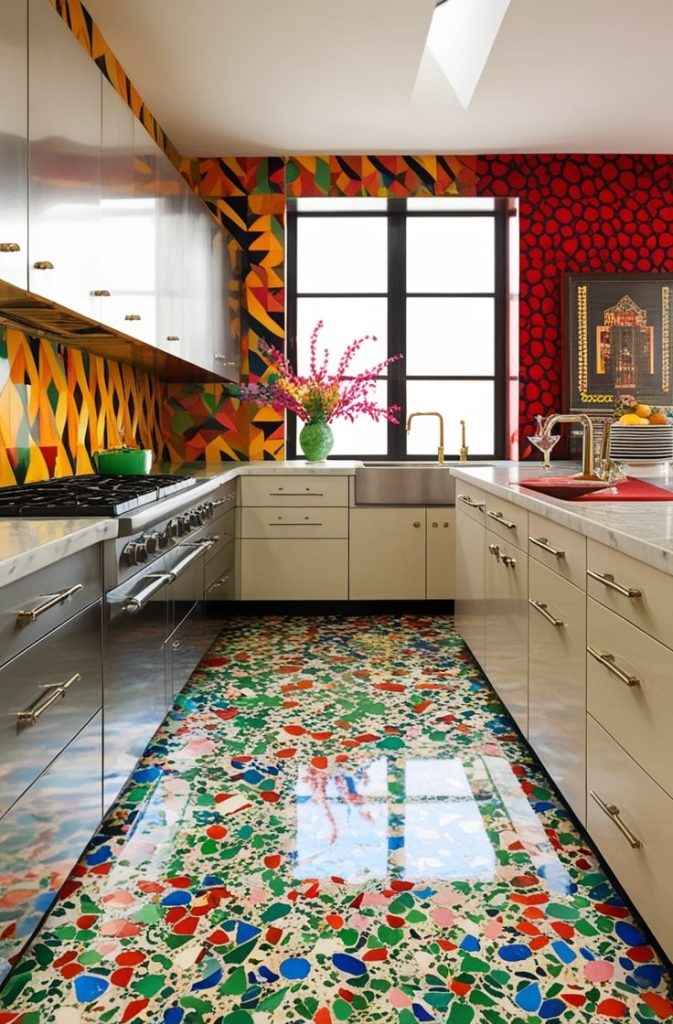
Terrazzo is having a moment. It’s a composite material with marble or glass chips, creating a speckled, retro-modern look. It’s durable and customizable, letting you play with colors and patterns.
Installation is complex and costly, so it’s not for everyone. Terrazzo fits bold, artistic, or retro kitchens and sits at the high-end price point. It’s a showstopper if you want something unique.
12. Brick Flooring
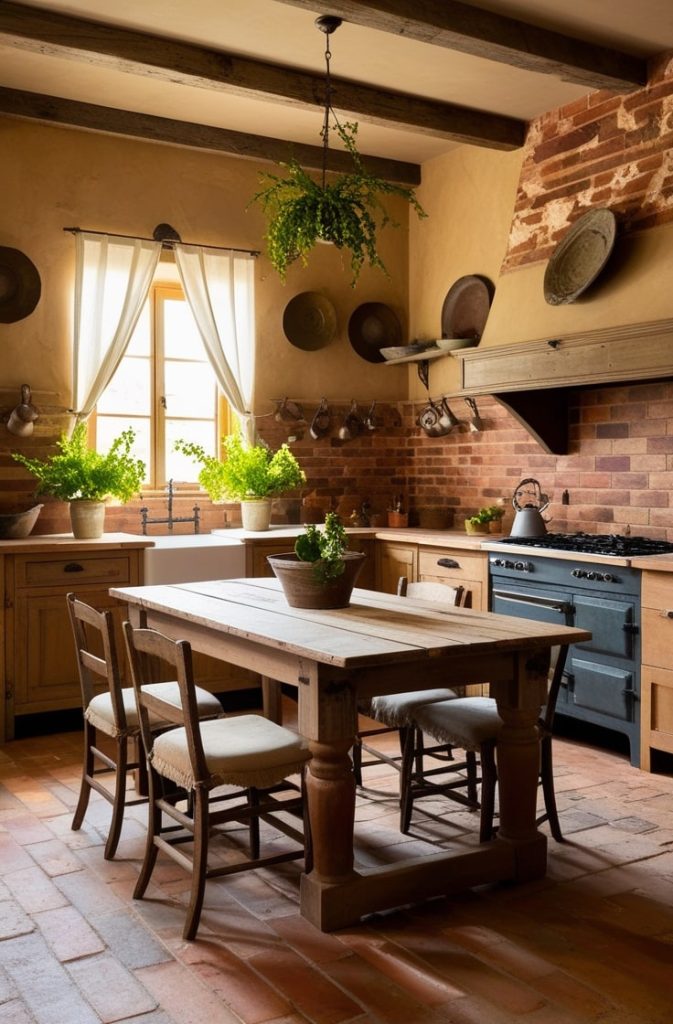
Brick flooring brings rustic charm. You can use reclaimed bricks or brick-look tiles for a warm, farmhouse feel. It’s durable and full of character, but the uneven surface can be tricky to clean, and it needs sealing. Brick is perfect for farmhouse or rustic kitchens and costs mid to high-end. It’s a bold choice that adds tons of personality.
13. Patterned Cement Tiles
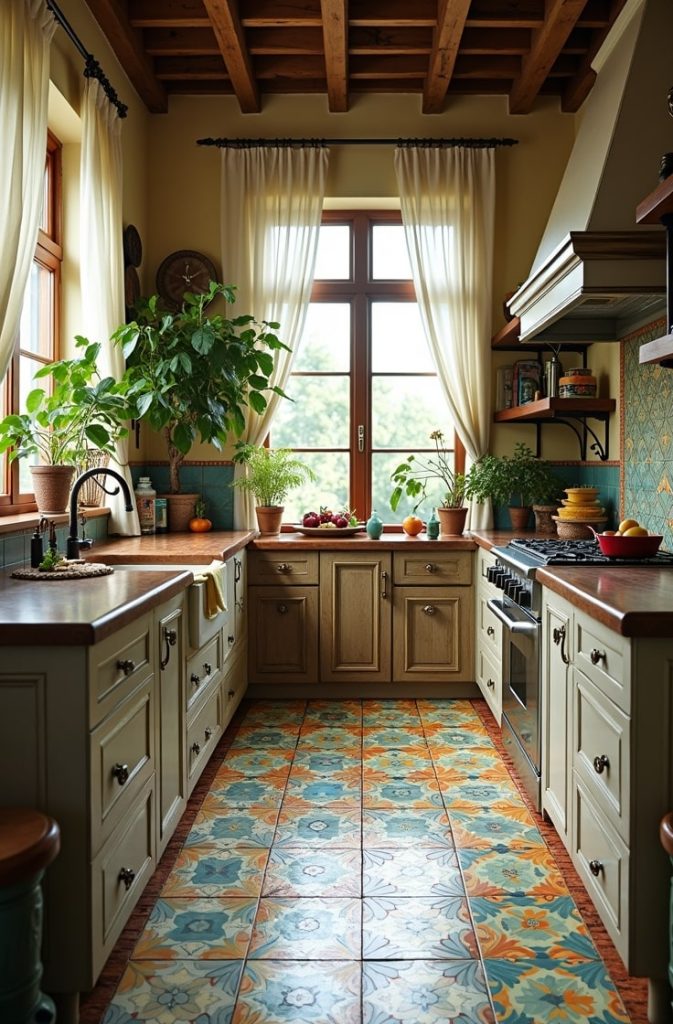
Patterned cement tiles are my favorite for adding flair. These handcrafted tiles come in vibrant colors and intricate designs, perfect for a bohemian or vintage vibe. They’re durable but need sealing to protect against stains.
They’re not cheap, and installation can be pricey, but the result is stunning. These tiles shine in bold, artistic kitchens and fall in the high-end price range.
14. Laminate Flooring
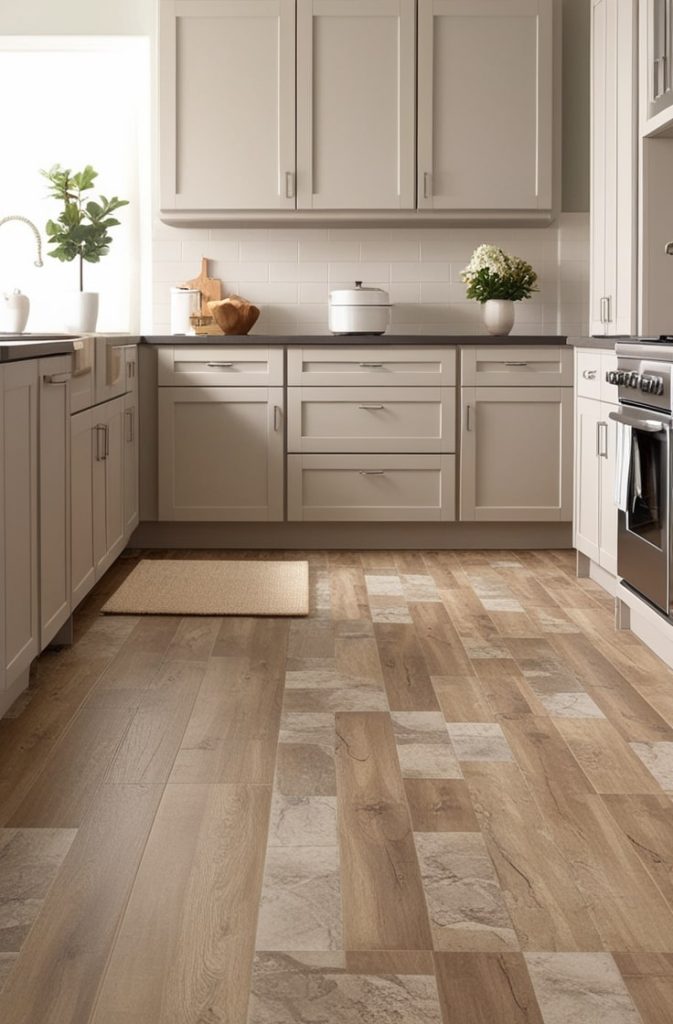
Laminate is a wallet-friendly option that mimics wood or stone. It’s easy to install, often with click-lock systems, and requires minimal maintenance. It’s not as durable as other options and isn’t water-resistant, so spills need quick attention. Laminate is great for budget-conscious or temporary kitchens and costs in the low range. It’s a practical choice for a quick refresh.
15. Linoleum Flooring
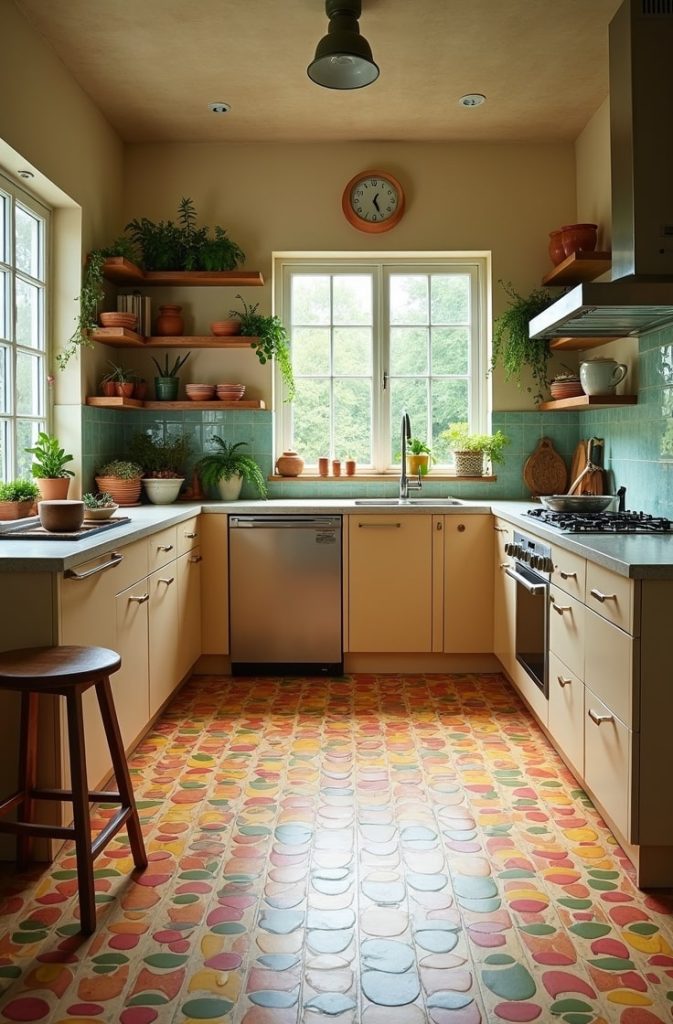
Don’t confuse linoleum with vinyl—it’s a natural, eco-friendly material made from linseed oil and other renewable resources. It’s durable, comes in vibrant colors, and is surprisingly versatile. It can dent and needs occasional waxing, but it’s a great green option. Linoleum fits eco-friendly or retro kitchens and costs low to mid-range. It’s a classic with a modern twist.
Comparison of Flooring Options
To make your decision easier, let’s compare these options. Here’s a quick table summarizing key factors:
| Flooring Type | Cost | Durability | Maintenance | Style | Eco-Friendly |
| Hardwood | Mid-High | High | Moderate | Traditional, Farmhouse | Moderate |
| Engineered Hardwood | Mid | High | Moderate | Modern, Transitional | Moderate |
| Porcelain Tile | Mid-High | Very High | Low | Contemporary, Eclectic | Low |
| Ceramic Tile | Low-Mid | Moderate | Low | Budget, Rental | Low |
| Luxury Vinyl Plank | Low-Mid | Moderate | Low | High-Traffic, Budget | Low |
| Vinyl Sheet | Low | Low-Moderate | Low | Rental, Temporary | Low |
| Cork | Mid | Moderate | Moderate | Cozy, Eco-Friendly | High |
| Bamboo | Mid-High | High | Moderate | Modern, Eco-Friendly | High |
| Concrete | Mid-High | Very High | Low | Industrial, Minimalist | Moderate |
| Natural Stone Tile | High | Very High | High | Luxury, Mediterranean | Moderate |
| Terrazzo | High | Very High | Moderate | Retro, Artistic | Moderate |
| Brick | Mid-High | High | Moderate | Farmhouse, Rustic | Moderate |
| Patterned Cement Tiles | High | High | Moderate | Bohemian, Vintage | Moderate |
| Laminate | Low | Low-Moderate | Low | Budget, Temporary | Low |
| Linoleum | Low-Mid | Moderate | Moderate | Retro, Eco-Friendly | High |
Decision Guide
Not sure where to start? Ask yourself:
- Budget: Can you splurge, or are you keeping costs low?
- Durability: Do you need something indestructible for a busy household?
- Style: Are you leaning toward modern, rustic, or something else?
- Maintenance: How much time can you dedicate to cleaning?
- Eco-Friendliness: Is sustainability a priority?
Your answers will point you to the perfect flooring. For example, if budget and durability are key, luxury vinyl planks are a great pick. If you want luxury and don’t mind maintenance, natural stone could be your match.
Design Tips for Kitchen Flooring
Your flooring doesn’t exist in a vacuum—it needs to work with your kitchen’s overall look. Here’s how to make it shine.
Color and Pattern
Choose colors that complement your cabinets and countertops. Light floors, like blonde hardwood or pale tiles, make small kitchens feel bigger. Dark floors, like slate or walnut, add drama but can show dirt. Patterns, like herringbone wood or geometric tiles, add personality. Test samples in your lighting to see how they pop.
Mixing Materials
Want to get creative? Combine materials for a custom look. Try a hardwood field with a tile border near the sink for practicality. Or use patterned cement tiles as an accent in a mostly vinyl kitchen. Just keep the transition smooth to avoid tripping hazards.
Trends
Right now, large-format tiles are huge—they create a clean, seamless look. Matte finishes are trending over glossy for a softer vibe. Herringbone and chevron patterns are also hot, especially in wood or tile. Stay timeless with neutral tones, or go bold with colorful cement tiles.
Space Considerations
Small kitchens benefit from light colors and smaller tiles to avoid overwhelming the space. Large kitchens can handle darker floors or bold patterns. Diagonal tile layouts can make any kitchen feel wider. Play with scale to enhance your room’s proportions.
Installation and Maintenance Tips
Installing and maintaining your flooring properly ensures it lasts. Here’s the lowdown.
Installation Overview
DIYers can tackle vinyl, laminate, or click-lock engineered hardwood with basic tools. Tiles, concrete, or terrazzo often need pros due to cutting, leveling, or grouting. Always prep your subfloor—clean, dry, and level—for the best results. Budget extra for underlayment or adhesives if needed.
Material-Specific Maintenance
- Hardwood/Engineered Hardwood: Sweep daily, mop with a wood-safe cleaner, and refinish every few years.
- Porcelain/Ceramic Tile: Sweep and mop with mild detergent. Regrout if needed.
- Vinyl/Laminate: Sweep and damp mop; avoid excess water.
- Cork: Vacuum regularly, reseal every 3-5 years, and avoid harsh cleaners.
- Bamboo: Similar to hardwood—sweep and use gentle cleaners.
- Concrete: Sweep and mop; reseal polished concrete every few years.
- Natural Stone: Seal annually, clean with pH-neutral products, and avoid acidic spills.
- Terrazzo: Sweep and mop; reseal periodically.
- Brick: Seal every 1-2 years; scrub with a soft brush for tough stains.
- Linoleum: Mop with mild soap; wax occasionally for shine.
Longevity Tips
Protect your floors with mats near sinks and stoves. Use felt pads under furniture to prevent scratches. Clean spills immediately to avoid stains or warping. For high-traffic areas, consider a durable topcoat or sealant.
Budget Planning and Cost Breakdown
Flooring costs vary widely. Here’s what to expect.
Cost Factors
- Materials: Vinyl and laminate are cheapest ($1-5/sq ft), while stone or terrazzo can hit $15-30/sq ft.
- Labor: Professional installation ranges from $2-10/sq ft, depending on complexity.
- Extras: Underlayment, adhesives, or subfloor prep can add $1-5/sq ft.
Saving Tips
Shop sales at big-box stores or online retailers. Consider remnants for small kitchens. DIY installation saves big on vinyl or laminate. For high-end looks on a budget, try porcelain tiles that mimic stone or wood.
Investment Value
Hardwood, stone, and porcelain can boost your home’s resale value, especially in luxury markets. Vinyl and laminate are less likely to impress buyers but work for short-term solutions. Choose durable options if you plan to stay long-term.
Eco-Friendly and Sustainable Options
If you’re passionate about the planet, you’ve got great choices.
Materials
Cork, bamboo, and linoleum are renewable and biodegradable. Reclaimed hardwood or recycled-content tiles also reduce environmental impact. Look for FSC-certified wood for sustainable harvesting.
Certifications
Check for low-VOC seals on vinyl or adhesives to keep indoor air clean. FSC certification ensures wood is responsibly sourced. Some tiles use recycled materials—ask suppliers for details.
Environmental Impact
Sustainable floors reduce deforestation and waste. Cork and bamboo grow quickly, making them renewable. Linoleum uses natural ingredients, unlike synthetic vinyl. Choosing eco-friendly options supports a healthier planet.
Conclusion
There you have it—15 kitchen flooring ideas to spark your imagination. From the timeless charm of hardwood to the bold flair of patterned cement tiles, there’s something for every style and budget.
Think about your needs—durability, maintenance, aesthetics, and sustainability. Use the comparison table and design tips to narrow down your choices. Your dream kitchen is just a floor away! Start exploring samples, check your budget, and get ready to transform your space.

I’m Sloane Everly, the heart and soul behind TheTidyPorch.com, where I pour my love for home decor, interior styling, and curated living into everything I do.
I’m all about turning houses into homes that feel like you—full of warmth, character, and a little bit of magic.
My style? Think cozy charm with a splash of bold, always designed to make your space feel like a hug you never want to leave.

